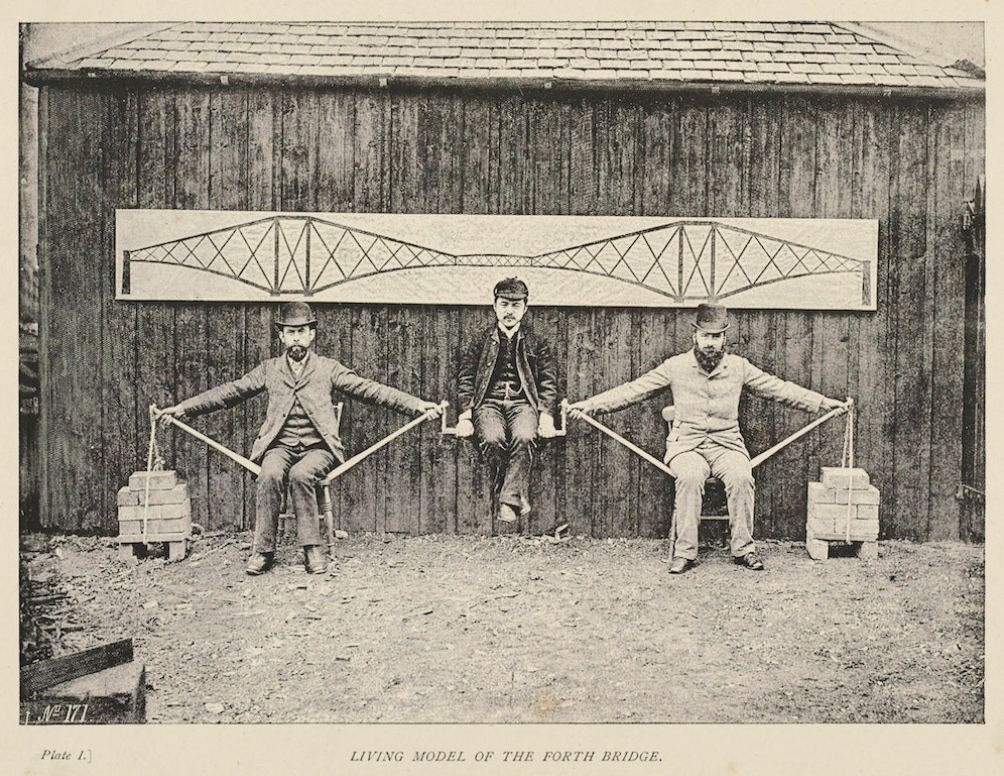The Forth Bridge in Pictures
By Brynn Gordon
What do we consider to be Fife’s most significant contribution to art and design?
Some might tentatively suggest Dundee’s McManus Art Gallery and Museum, or the ruins of St Andrews Cathedral. A few might even suggest that compared to Glasgow, Edinburgh, and the Highlands, Fife has provides relatively little art historical significance.
Personally, I would disagree and nominate the Forth Rail Bridge: used daily by tens of thousands to make the Queensferry crossing, it is a visually striking monument to the longevity of Victorian engineering. Painted an eye-catching deep red, the massive steel cylinders and girders from a distance almost seem to be an abstract industrial statue, the three double trapezoids distributing the weight of the rails in an elegant and simple way. Through the National Library of Scotland’s photo archive of the bridge’s construction, we may get a better understanding of the enduring nature of the Forth Bridge.
Colored by the Tay Bridge disaster of 1879, when violent winds caused the bridge to collapse while a train was passing over, the planning process for the Forth Rail Bridge began in the late 1870s. Sir John Fowler and Sir Benjamin Baker were appointed with this catastrophe in mind to create a bridge that would be impervious to such disasters, and would appear so strong that the Scottish public would feel it was safe to use.
Phillip Phillips, Inchgarvie Cantilever as Seen From the Landing Stage, Forth Bridge Illustrations 1886-1887.
Due to technological advances, the building of a more stable bridge was simple. New industrial processes had become commercially viable, meaning that engineers could work in durable, long-lasting steel rather than the wrought iron used in the Tay bridge. Additionally, through the innovative use of cantilevers, where a protruding horizontal element is attached to a vertical element at one end with an anchor, the bridge was able to support itself.
Benjamin Baker, Living Modle of the Forth Bridge, Bridging the Firth of Forth, 1887.
The three trapezoid shapes are constructed of double cantilevers, each attaching the central girder to the top and bottom of each tower, distributing the weight of any passing trains without putting pressure on any single joint.
Phillip Phillips, Forth Bridge. Fife cantilever with No. 1 strut and lifting platform nearly up to rail level, The Forth Bridge illustrations, 1886-1887, National Library of Scotland.
The triangular shape of the towers only further ensured trains’ safety, as triangles are considered the strongest, most stable shape.
Fowler and Baker were known for creating workable solutions to difficult engineering problems, including the London underground, which lent their design weight among other civil engineers and industrialists. Convincing a public reeling from tragedy to trust large bridges again was more difficult, and it was here where Fowler and Baker’s design sensibilities were able to shine. While the Forth Bridge may not appear to follow any aesthetic in particular, its embrace of pure, honest engineering was a considered, deliberate choice.
Typical Victorian sensibility dictated for ornamentation and decoration on every available surface. Most of Tower Bridge’s more dramatic elements draw from that era. Compared to this, and the highly decorated engineering we know Victorians were capable of in the Crossness sewage plant, the Bridge is bare. This open, almost skeletal quality reveals the inner workings of the bridge’s suspension and weight distribution to viewers, the visually “unsupported” areas making up only fraction of the distance. In this way, travelers trusted the structure more as they were able to discern its strength for themselves, a tactic still used in many civil engineering projects today.
Phillip Phillips, Imaginative depiction of the Forth Rail Bridge, The Forth Bridge illustrations, 1886-1887, National Library of Scotland.
The Forth Rail Bridge is as impressive now as it was in 1880. It's enduring charm and unique appearance are testified through its frequent appearances in pop culture (fascinating Hitchcock in the 39 steps). and appearing on countless t-shirts and models. Whatever one may personally think of it, the elegant solution Fowler and Baker present to problems of civil engineering and public perception are masterful, and I for one am glad this modern marvel belongs to Fife.
Alfred Hitchcock, still from The 39 Steps showing the Forth Rail Bridge, 1935.
Bibliography
Dennis, Gareth. “The Forth Bridge: Greatest Structure in the World?” Medium. March 2020. https://garethdennis.medium.com/the-forth-bridge-greatest-structure-in-the-world-8584b383616f.
Metcalfe, Alison. “The Forth Bridge: Building an Icon.” The Public Domain Review. March, 2023. https://publicdomainreview.org/essay/the-forth-bridge-building-an-icon.
Muscato, Christopher. “Forth Bridge: History, Design & Construction” Study.com. 2020. https://study.com/academy/lesson/forth-bridge-history-design-construction.html.
UNESCO World Heritage Centre. “The Forth Bridge.” UNESCO World Heritage Centre. 2015. https://whc.unesco.org/en/list/1485/.





